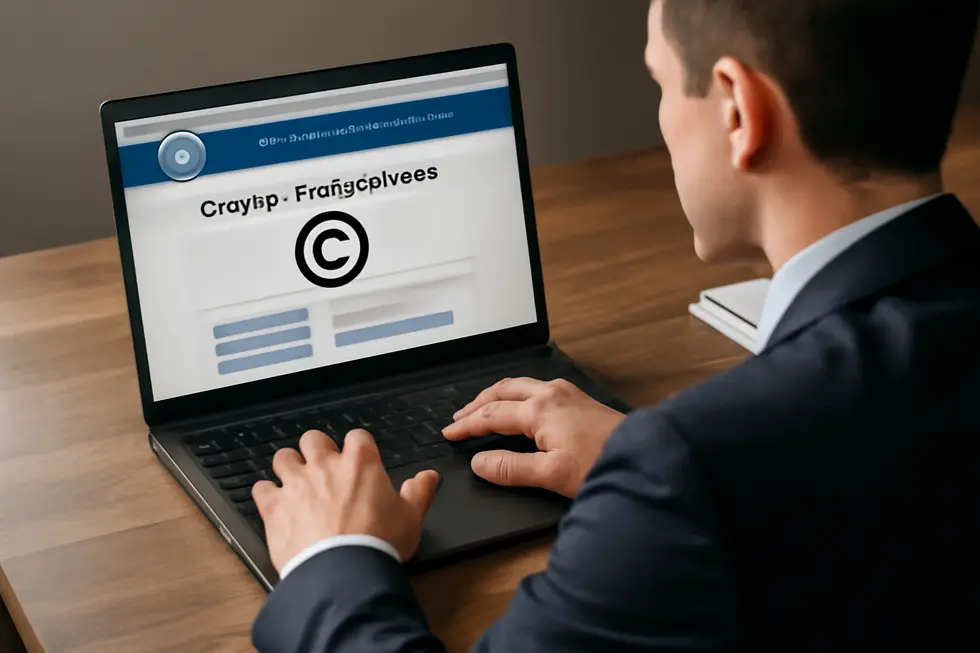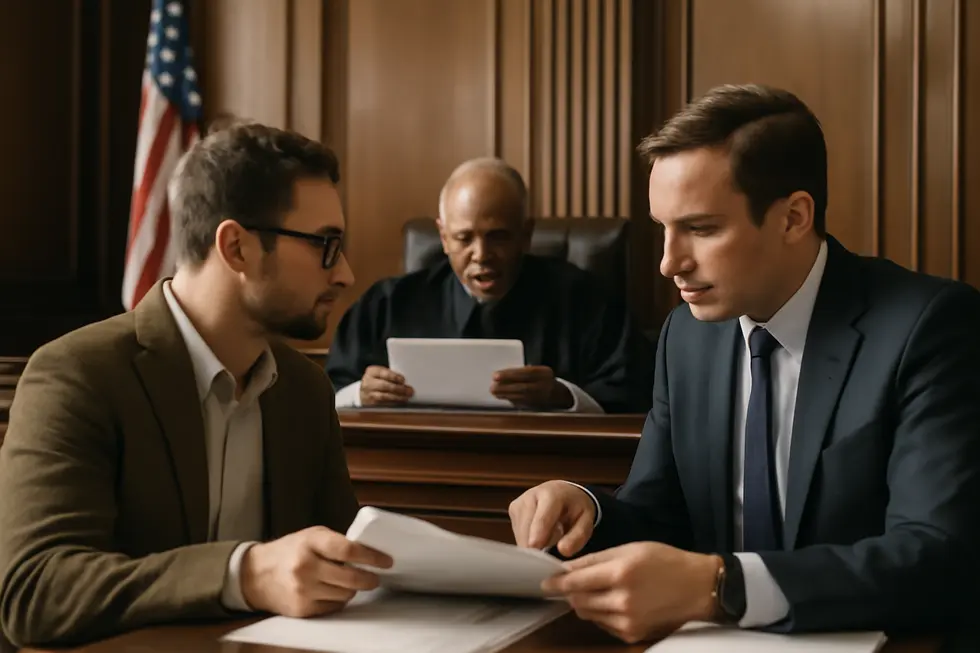Introduction
Copyright protection plays a pivotal role in securing the value of your business’s creative assets. From the instant a work is crafted and fixed in any tangible form, copyright law grants automatic rights to the creator. This immediate protection means your ideas and innovations gain legal recognition without delay or formal requirement. Understanding how this principle applies empowers business owners to confidently manage intellectual property and navigate enforcement options. Each chapter unfolds critical facets: first, the foundation of automatic rights; then how the fixation requirement triggers protections; followed by the ongoing importance of registering your work; essential legal advantages linked to timely recognition; and finally, how early copyright safeguards encourage a culture of creativity essential for business growth.
Tables of Contents
Chapter 1: Understanding How Copyright Protection Begins as Soon as the Work is Created: The Principle of Automatic Rights
- The Legal Cornerstone of Automatic Copyright: When Originality Meets Fixation
- Navigating Digital Creation: How Technology Shapes Automatic Copyright Protection from the Moment of Fixation
- The Economic Incentives and Cultural Impact of Automatic Copyright Protection
Chapter 2: Fixation Requirement and Its Role in Copyright Protection Beginning As Soon As the Work is Created
- How Modern Technology Shapes the Fixation Requirement and Ensures Immediate Copyright Protection
- Economic Impact of Fixation: How Tangibility Shapes Copyright’s Value and Market Dynamics
- How the Fixation Requirement Shapes Legal Certainty and Societal Balance in Immediate Copyright Protection
Chapter 3: The Importance of Registration Even Though Copyright Protection Begins as Soon as the Work is Created
- Unlocking Legal Strength: How Registration Solidifies Copyright Ownership and Litigation Power
- How Registration Empowers Enforcement and Deters Infringement Beyond Automatic Copyright
- Unlocking Commercial Potential: How Copyright Registration Elevates Creative Works into Valuable Business Assets
Chapter 4: Legal Advantages and Enforcement When Copyright Protection Begins as Soon as the Work is Created
- Unlocking Immediate Rights and Legal Enforcement: How Copyright Grants Ownership from the Moment You Create
- Enhancing Your Copyright Protection: How Registration Empowers Enforcement and Legal Remedies
- Maximizing Enforcement and Remedies: Practical Steps After Copyright Automatically Arises
Chapter 5: Encouraging Creativity Through Early Copyright Protection Beginning as Soon as the Work is Created
- How Automatic Copyright Attachment Empowers Creators to Protect and Promote Their Original Works from the Start
- Unlocking Legal and Economic Power: How Early Copyright Registration Enhances Creative Control
- Strengthening Creative Confidence: Effective Enforcement and Accessibility in Early Copyright Protection
Chapter 1: Understanding How Copyright Protection Begins as Soon as the Work is Created: The Principle of Automatic Rights

1. The Legal Cornerstone of Automatic Copyright: When Originality Meets Fixation
Copyright protection springs into existence the moment an original work is fixed in a tangible form. This legal cornerstone, known as the automatic vesting of copyright, means creators do not need to register their work, publish it, or attach a copyright notice to claim protection. Rather, the law immediately grants exclusive rights, shielding their creative expressions from unauthorized use.
At the heart of this principle lies the fixation requirement. The work must be captured in a medium that is stable enough to be perceived or reproduced over time—whether that means writing on paper, saving a digital file, or recording audio. Once fixed, the creation transcends mere ideas, entering the realm of protected expression. Equally essential is the element of originality. The work must reflect at least a minimal degree of creativity and not be a direct copy of another’s creation.
Upon fixation, a bundle of exclusive rights automatically applies to the creator, including the right to reproduce, adapt, distribute, publicly perform, and display the work. This protection endures for the creator’s lifetime plus 70 years in most cases, ensuring long-term safeguarding of intellectual property. While no formal registration is necessary to obtain these rights, securing registration provides added legal muscle, particularly when enforcing rights or pursuing infringement claims.
This automatic recognition of copyright is internationally affirmed, harmonized through agreements like the Berne Convention, which eliminates dependence on formalities worldwide. Courts constantly interpret and refine how this principle applies, ensuring creators maintain their fundamental protections.
For creators seeking to understand how these protections function practically—such as in literary works or multimedia creations—further insights can be found through comprehensive resources like those provided by the U.S. Copyright Office.
Learn more about these legal fundamentals through authoritative materials at the U.S. Copyright Office.
Additionally, for businesses and individual creators alike, grasping the spectrum of benefits from copyright protection can be essential. Explore detailed guidance on the benefits of copyright registration for business.
2. Navigating Digital Creation: How Technology Shapes Automatic Copyright Protection from the Moment of Fixation
Copyright protection activates automatically the instant an original work is fixed in a tangible medium, whether physical or digital. Advances in technology have transformed the ways creators capture and preserve their expressions, profoundly expanding the concept of fixation. Today, tools like computers, smartphones, and digital audio or video recorders enable creators to secure copyright protection immediately and effortlessly upon creation. This swift digital fixation underscores the practical strength of the principle of automatic rights, as no formal registration or copyright notice is required to gain ownership from the start.
The scope of protected works has broadened dramatically in the digital age. Not only traditional expressions like literary texts and musical compositions qualify for copyright, but also digital art, software code, and even informal sketches captured electronically. This inclusiveness ensures creators of diverse digital content enjoy the same fundamental protections as conventional creators.
However, challenges arise with cutting-edge technologies such as artificial intelligence. Copyright law, grounded in human creativity, currently denies protection to works generated solely by AI without meaningful human involvement. When human creators exert significant control over AI output, protection may exist. These distinctions illustrate ongoing legal efforts to reconcile technology’s evolution with longstanding copyright principles.
As legal frameworks adapt—refining definitions of authorship and fixation to account for digital realities—creators must understand that technology both enables immediate protection and raises complex ownership questions. For guidance on enforcing rights and licensing digital or mixed media works, exploring dedicated resources on the benefits of copyright registration can offer valuable insights.
For comprehensive advice on the automatic rise of copyright from the point of fixation and its technological context, the U.S. Department of Interior Intellectual Property brochure provides authoritative information and best practices.
3. The Economic Incentives and Cultural Impact of Automatic Copyright Protection
Copyright law grants creators exclusive rights automatically upon fixation of their original work in a tangible medium. This immediate protection serves as a powerful economic incentive, encouraging innovation and artistry across industries such as literature, music, software, and visual arts. By legally controlling reproduction, distribution, and adaptation, creators can confidently monetize their works through licensing agreements or sales, knowing their interests are safeguarded against unauthorized use.
This framework nurtures the creative economy by fostering sustained investment. The extended duration of copyright protection—often lasting decades beyond the creator’s life—ensures that economic benefits flow not only to original authors but also to heirs and businesses that support creators. Such longevity motivates ongoing cultural production, as investments in creating and refining works can yield enduring returns.
On a societal level, automatic copyright promotes cultural enrichment and knowledge dissemination. It enables creators to share original expressions while maintaining legal rights, balancing protection with eventual public access after copyright expiration. Fair use and other legal exceptions are critical here, allowing educators, researchers, and transformative artists to reuse copyrighted works without undermining creators’ economic interests.
Importantly, the lack of formal registration requirements lowers barriers globally, providing immediate protections even in jurisdictions with varying legal infrastructures. Though registration is voluntary, it offers stronger enforcement tools in infringement disputes and facilitates easier licensing.
These combined effects demonstrate how automatic copyright protection underpins a dynamic ecosystem where creative endeavors thrive economically and culturally. This robust balance promotes a vibrant exchange of ideas while ensuring creators receive the recognition and control they deserve.
For a detailed exploration of copyright basics, visit Connecticut State Library Copyright Basics.
Chapter 2: Fixation Requirement and Its Role in Copyright Protection Beginning As Soon As the Work is Created

1. How Modern Technology Shapes the Fixation Requirement and Ensures Immediate Copyright Protection
The fixation requirement serves as the critical bridge between an intangible idea and a protected copyrighted work. It mandates that a creative expression must be captured in a tangible form to trigger copyright protection automatically from the moment of creation. Traditionally, fixation meant writing on paper or recording on physical media, but advances in technology have vastly expanded this concept. Today, fixation includes digital files saved on computers, servers, or cloud storage, audio and video recordings, as well as computer code and multimedia content. This broader technological scope ensures that creators’ rights arise immediately once their work is embodied in any perceivable, stable form.
This technology-driven expansion of fixation is crucial in distinguishing protected works from mere concepts or fleeting expressions. For example, a song’s melody or lyrics become protected as soon as they are recorded or typed out—not when merely conceptualized in the brain. Similarly, software code must be fixed as tangible data on a storage device or digital medium to qualify for protection. Emerging issues such as AI-generated imitations highlight the importance of fixation; AI mimicry does not create new copyrighted material without producing a new, fixed original work. Thus, only the original recordings or coded expressions fixed in a tangible form receive legal protection.
Ultimately, the fixation requirement as shaped by modern technology underpins copyright’s automatic inception. It adapts to evolving formats while preserving the boundary that protects expressions but not abstract ideas. This ensures creators gain immediate and enforceable rights upon creating original works in any technological medium. For creators seeking further guidance on copyright fundamentals, resources such as copyright protection for books, movies, and songs can be particularly helpful.
For a detailed overview on fixation and copyright protections, see this LegalZoom article.
2. Economic Impact of Fixation: How Tangibility Shapes Copyright’s Value and Market Dynamics
The fixation requirement is pivotal not only legally but also economically, as it marks the exact moment copyright protection begins by demanding that a work be embodied in a tangible medium. This threshold transforms abstract ideas into concrete expressions, qualifying them for exclusive rights. Economically, fixation allows creators to capture value by controlling reproductions and distributions of their work. This exclusivity often enables the creator to set prices above competitive levels, generating revenue streams that compensate for their creative investment.
However, this economic control introduces inefficiencies. Higher prices stemming from exclusivity restrict access for some consumers, creating a deadweight loss where potential gains from trade do not materialize. While producers gain income, society may experience reduced overall welfare due to limited dissemination.
Moreover, fixation’s economic role extends to its influence on follow-on creativity. By protecting only fixed works, rights holders can limit or monetize derivative uses, potentially discouraging other creators from building upon existing content. This can slow cultural innovation and creative evolution, presenting a trade-off between protecting original works and fostering new ideas.
On the other hand, fixation provides clear legal certainty. By requiring that works be fixed, the law sets a tangible standard that helps courts and individuals identify when protection starts. This clarity reduces disputes and supports economic decision-making by creators, investors, and businesses, enabling them to plan creatively and financially with confidence.
In effect, fixation balances the encouragement of creativity through exclusive economic benefits with the broader societal interest of accessibility and further innovation. Understanding this interplay is essential to appreciating why copyright protection begins the moment a work is fixed.
For a comprehensive economic analysis of the fixation requirement and its broader implications, see the detailed work by Landes and Posner here.
3. How the Fixation Requirement Shapes Legal Certainty and Societal Balance in Immediate Copyright Protection
The fixation requirement plays a crucial role in anchoring copyright protection at the precise moment a creative work is captured in a tangible medium. By demanding that a work be fixed—whether written, recorded, or otherwise embodied in physical or digital form—copyright law establishes a clear and objective starting point for legal protection. This clarity prevents ambiguity over whether fleeting ideas or purely conceptual expressions are protected, which helps courts handle infringement disputes more effectively.
From a legal standpoint, fixation affords creators immediate exclusive rights to reproduce, distribute, perform, display, and adapt their original works. This early protection incentivizes creativity, allowing authors and artists to control usage and monetize their outputs as soon as their work transitions from thought to tangible expression. Moreover, fixation empowers enforcement against unauthorized copying or recording, such as illicit captures of live performances, since unauthorized fixations can themselves constitute infringements under statutes like 17 U.S.C. §1101.
Beyond legal mechanics, fixation influences broader societal outcomes. Protecting creators immediately supports a robust creative economy by encouraging investment in original works. However, this advantage is balanced against societal trade-offs, including potential barriers for subsequent innovators who must navigate licensing requirements or restrictions on derivative works. Such restrictions can limit access and increase costs for consumers, highlighting the ongoing tension between exclusive rights and public domain benefits.
Ultimately, the fixation requirement is foundational in defining when copyright protection begins, ensuring reliable legal boundaries that uphold authors’ interests while framing the delicate balance between incentivizing creativity and promoting innovation. For those interested in deeper legal perspectives on fixation triggering immediate copyright protection, the University of Memphis Copyright Basics offers comprehensive guidance.
Chapter 3: The Importance of Registration Even Though Copyright Protection Begins as Soon as the Work is Created

1. Unlocking Legal Strength: How Registration Solidifies Copyright Ownership and Litigation Power
Copyright protection attaches automatically the moment an original work is fixed in tangible form. Yet, this automatic right remains largely intangible until the copyright holder takes the step to formally register the work. Registration transforms this innate protection into a robust legal tool, providing critical advantages that extend far beyond the initial creation.
Primarily, copyright registration establishes a public record that serves as prima facie evidence of ownership, which is invaluable if the copyright holder must defend their work in court. This official recognition simplifies enforcement by clearly documenting the claim and the date of creation, making it more difficult for challengers to dispute the author’s rights. Without registration, any legal action to stop infringement may be delayed or complicated, as in many jurisdictions, including the United States, registration is a mandatory prerequisite for filing a federal lawsuit for copyright infringement.
Moreover, early registration—especially within five years of publication—strengthens the rights holder’s legal position by diminishing challenges to the work’s originality or validity. The registration also opens access to statutory damages and attorney’s fees, remedies that are not otherwise available and that incentivize potential infringers to respect copyright boundaries. These financial protections not only compensate for losses but also serve as a deterrent against unauthorized use, signaling the creator’s serious commitment to defending their intellectual property.
Beyond litigation, registration can facilitate business activities such as licensing and commercializing a work by providing a clear legal foundation recognized by partners and courts alike. It turns the copyright from a mere theoretical right into an actionable asset, ready to support enforcement and commercial endeavors with greater confidence.
For a deeper exploration of how registration benefits copyright owners, particularly in the realm of publishing, see the detailed insights on the benefits of copyright registration for business.
Through registration, creators maintain their automatic rights while gaining a powerful shield to protect and capitalize on their creative output.
2. How Registration Empowers Enforcement and Deters Infringement Beyond Automatic Copyright
While copyright protection is automatic the moment your original work is fixed in a tangible medium, registration plays a crucial role in enhancing both enforcement power and deterrence against unauthorized use. It is the registration that creates a public record of your ownership, providing clear evidence that can dissuade potential infringers from copying or exploiting your work without permission. In most U.S. courts, registration is a prerequisite to filing an infringement lawsuit, making it an essential procedural step for creators who want to assert their legal rights effectively.
Registering your copyright early not only enables you to pursue legal action but also opens the door to critical remedies often unavailable without registration. These include statutory damages and attorneys’ fees—financial tools that can significantly strengthen your position in court. Additionally, timely registration offers prima facie evidence of ownership, which reduces the burden of proof and expedites dispute resolution. Such benefits collectively create a robust framework that supports creators in protecting their creations beyond the baseline automatic rights.
Beyond the courtroom, registration acts as a public deterrent. Knowing a work is officially registered signals to others that the creator is serious about protecting their intellectual property. Combining registration with proactive strategies—like documenting creation dates meticulously, applying digital watermarks, and monitoring for infringements—further fortifies your defenses. This comprehensive approach maximizes both prevention and control over your work’s use, ensuring your rights are respected.
Thus, while automatic copyright protection is the foundation, registration is the vital tool that converts those innate rights into tangible legal strength and practical deterrence against infringement. For an in-depth perspective on enforcement challenges without registration, see external analysis here: https://aaronhall.com/failure-to-register-copyright-enforcement-cases/. For additional valuable insights on copyright protection, consider exploring benefits of copyright registration in business.
3. Unlocking Commercial Potential: How Copyright Registration Elevates Creative Works into Valuable Business Assets
Copyright protection arises automatically the moment a work is fixed in a tangible medium, granting creators immediate ownership rights. However, while this automatic protection secures basic rights, formal registration significantly enhances the economic and commercial potential of creative works. Registering a copyright establishes a legal presumption of validity, which strengthens an owner’s position in disputes and allows more effective enforcement of rights. This legal recognition transforms intangible creations into tangible business assets that can be managed, licensed, and monetized.
Registered copyrights unlock the opportunity for creators and businesses to generate revenue through licensing agreements and rights sales. By formalizing ownership, registration enables copyright holders to negotiate licensing deals that create consistent income streams, such as royalties or fees. This commercialization turns creative efforts from mere expressions into strategic financial resources that contribute directly to a company’s value. Moreover, the ability to enforce rights in court with eligibility for statutory damages and attorney’s fees acts as a powerful deterrent against infringement, preserving the work’s commercial viability.
Beyond immediate financial benefits, registered copyrights increase a business’s attractiveness to investors and partners by signaling credible, well-managed intellectual property. They facilitate sound asset management strategies, including tax planning and risk mitigation, vital for long-term sustainability. Proper registration helps companies manage their intellectual property portfolio effectively, fostering revenue diversification and protecting those revenues.
Although copyright protection begins at creation, registration is essential for fully realizing the work’s commercial worth. It elevates the copyright from a basic legal right to a strategic business asset, opening doors to licensing income and stronger legal protections. For a detailed explanation of these registration benefits and their business impact, see the benefits of copyright registration for business.
External Reference: Kindlepreneur’s overview of book copyright registration highlights how formal registration enhances licensing prospects and intellectual asset management.
Chapter 4: Legal Advantages and Enforcement When Copyright Protection Begins as Soon as the Work is Created

1. Unlocking Immediate Rights and Legal Enforcement: How Copyright Grants Ownership from the Moment You Create
Copyright protection arises automatically the instant an original work is fixed in a tangible medium, whether typed, written, recorded, or otherwise captured. From this precise moment, the creator holds exclusive rights to reproduce, distribute, publicly display, perform, and develop derivative works based on the original creation. This immediate legal ownership means you do not need to file any paperwork or register the work to claim initial protection. It safeguards unauthorized use and ensures the creator controls how their work is shared or adapted.
This automatic protection applies equally to published and unpublished works, provided they are fixed in a material form. These rights empower creators to maintain full authority over their intellectual property from the outset, effectively deterring infringement through clear ownership.
However, while these rights are inherent immediately, registering the copyright with the U.S. Copyright Office offers critical enforcement advantages. Registration creates an official public record of ownership, bolstering evidence in case of legal disputes and establishing the formal standing necessary to assert claims in court.
Additionally, registration unlocks the potential to seek statutory damages and attorney’s fees—remedies unavailable without formal registration. This enhances the ability to pursue infringement suits effectively and recover significant compensation if rights are violated.
Thus, creators benefit from a two-fold system: instant, automatic rights rooted in the moment of creation, alongside the optional step of registration which strengthens legal enforcement and remedies. Together, these mechanisms ensure creators both own and can defend their works robustly.
For further insights on maximizing these protections, explore how registering copyright can benefit your business at benefits copyright registration business.
External resource: LegalZoom – Securing Copyright Protection for Your Creative Work
2. Enhancing Your Copyright Protection: How Registration Empowers Enforcement and Legal Remedies
Copyright protection arises automatically the moment an original creation is fixed in a tangible medium, granting the creator exclusive rights without any formal process. However, registering that copyright with the U.S. Copyright Office significantly enhances these rights, especially when enforcement becomes necessary. Registration creates an official public record establishing clear evidence of ownership, which serves as prima facie proof in legal disputes. This record simplifies the burden of proof in infringement cases, helping courts quickly recognize the validity of the copyright claim.
Beyond evidentiary benefits, registration unlocks important legal remedies. Unregistered works cannot typically access statutory damages or attorney’s fees, which can be crucial for deterring infringement and obtaining fair compensation. Registration also often acts as a prerequisite to filing suit. Without timely registration, certain enforcement options may be foreclosed, restricting a creator’s ability to address unauthorized use of their work effectively.
In today’s digital landscape, registration also facilitates more proactive protection methods. Rights holders can leverage AI-driven monitoring tools that search online platforms for pirated or altered copies of their work. These technologies enable swift identification of infringement, allowing creators to enforce their rights promptly. This combination of formal registration and active vigilance forms a comprehensive safeguard against misuse, particularly for digital content such as videos, books, or online courses.
While the automatic nature of copyright encourages creativity by offering immediate protection, registration empowers creators with a stronger legal toolkit. From establishing incontestable ownership to gaining access to statutory damages and litigation rights, formal registration complements the inherent rights granted at creation. Creators seeking robust defense of their intellectual property will find that registering their work is a critical step toward maximizing enforcement and preserving the value of their creations.
For further insights on the benefits of formally protecting your creations, explore detailed resources such as benefits of copyright registration for businesses. An authoritative guide by the U.S. Department of Interior also elaborates on these legal advantages in depth.
3. Maximizing Enforcement and Remedies: Practical Steps After Copyright Automatically Arises
Copyright protection starts the moment an original work is fixed in a tangible form, granting the creator immediate exclusive rights without the need for registration. These rights include reproduction, distribution, public display, performance, and authorization to create derivative works. Despite this automatic protection, practical enforcement often hinges on strategic actions to safeguard these rights and address infringement effectively.
While copyright registration is not a prerequisite for protection, it offers crucial legal benefits. Registering with an official body, such as the U.S. Copyright Office, creates an official public record that strengthens a creator’s position during enforcement. Without registration, pursuing litigation may be limited or less effective, as registration is generally required before filing an infringement lawsuit. Additionally, registration unlocks access to statutory damages and attorney’s fees, enhancing the remedies available in court.
Proactive vigilance plays a vital role in enforcement. Creators are encouraged to monitor how their works are used across various media, employing manual searches or automated tools to detect unauthorized copies or distributions. Displaying a clear copyright notice on works serves as a deterrent by visibly asserting ownership and clarifying that the work is protected.
When infringement is discovered, sending a cease-and-desist letter often resolves disputes without costly litigation. This formal communication demands that infringers stop unauthorized use and can lead to amicable settlements. If informal measures fail and the work is registered, a creator may pursue legal action seeking injunctions to halt continued infringement, monetary awards including statutory damages, and reimbursement of legal costs. Courts may also order destruction or forfeiture of infringing copies.
In summary, while copyright protection arises instantly upon creation, fortifying and enforcing those rights relies on registration, vigilant monitoring, clear notices, and assertive responses to infringement. These steps collectively empower creators to protect their intellectual property and assert their exclusive rights effectively.
For further insight into copyright registration advantages, see the detailed discussion on the benefits of copyright registration for businesses.
More about official guidance on copyright protection can be found through the U.S. Copyright Office resources.
Chapter 5: Encouraging Creativity Through Early Copyright Protection Beginning as Soon as the Work is Created

1. How Automatic Copyright Attachment Empowers Creators to Protect and Promote Their Original Works from the Start
Copyright protection is uniquely designed to empower creators by automatically attaching to their original works the moment these are fixed in a tangible medium. This immediate legal recognition eliminates the need for formal registration or any procedural steps to secure basic rights, providing creators with exclusive control over their expression from inception. Such exclusivity means the creator alone has the right to reproduce, distribute, display, and create derivative works, effectively deterring unauthorized use and fostering a fertile environment for creativity.
The benefit of automatic copyright attachment is twofold. Firstly, it reduces uncertainty and barriers for creators, enabling them to invest time and resources into developing their works with confidence. This foundational protection guarantees that their intellectual efforts are safeguarded without delay or complexity. Secondly, it establishes a clear legal starting point for ownership, which can later be transferred or licensed as creators choose, facilitating commercial opportunities and collaborations.
While this automatic protection forms the cornerstone of copyright law, optional registration offers additional legal advantages. Registering a work enhances enforcement capabilities by allowing creators to pursue infringement lawsuits and access statutory remedies. However, these benefits build upon—not replace—the immediate rights granted by automatic attachment.
The system also carefully balances creators’ rights with public interests, maintaining exceptions like fair use to encourage education, commentary, and parody without hindering innovation. In the digital age, technologies such as content identification and digital watermarking support enforcement of these automatic rights, while protecting against misuse through procedural safeguards.
Overall, automatic copyright attachment plays a critical role in encouraging creativity. It provides authors, artists, and creators with prompt and secure legal recognition, underpinning the confidence necessary to produce original works. For those interested in how this applies to specific formats like video, comprehensive guidance is available at how to copyright a video.
For further understanding of copyright’s nurturing effect on creative business ventures, explore benefits of copyright in business.
2. Unlocking Legal and Economic Power: How Early Copyright Registration Enhances Creative Control
While copyright protection automatically arises the moment an original work is fixed in a tangible form, registering that copyright early significantly strengthens a creator’s position. Registration transforms the automatic right into a powerful legal tool, enabling creators to defend their interests with greater authority and obtain financial remedies that would otherwise be out of reach.
One of the most critical advantages of early registration is access to federal courts for infringement disputes. Without registration, pursuing such legal action is not possible, effectively limiting enforcement. When a work is registered before infringement or within three months of its publication, the owner gains eligibility to claim statutory damages and attorney’s fees. These damages can range from $750 to $30,000 for standard infringement and can escalate to $150,000 if willful infringement is proven. This system allows creators to secure compensation without the burden of proving exact financial losses.
Moreover, a registration certificate serves as prima facie evidence of ownership, shifting the burden of proof onto the infringing party and simplifying legal proceedings. This evidentiary role encourages quicker resolutions, either through settlements or takedown actions, reducing costly and prolonged disputes.
Economically, early registration empowers creators to protect and monetize their works more effectively. It deters potential infringers by signaling strong enforcement capabilities and facilitates licensing deals, contributing to sustainable income streams that motivate continued creative output.
The combination of these legal protections and economic incentives cultivates an environment where creators can confidently share original work while retaining control over its use. For more about the tangible upsides of this process, see benefits of copyright registration business and external insights at Copyright Registration Benefits.
3. Strengthening Creative Confidence: Effective Enforcement and Accessibility in Early Copyright Protection
Strengthening Creative Confidence: Effective Enforcement and Accessibility in Early Copyright Protection
Copyright protection arises automatically the instant an original work is fixed in a tangible form. Yet, to fully support creators and encourage ongoing innovation, practical enforcement and accessibility strategies play a vital role. While the foundational right exists without any formalities, creators gain significant advantages by registering their works early. This establishes an official record of ownership and strengthens legal grounds if infringement occurs. Early registration also dates the work’s creation, helping resolve disputes with clear evidence.
Beyond registration, vigilant monitoring of unauthorized use helps creators detect infringement at its earliest stages. This can involve manual searches or employing digital tools that scan online platforms for unauthorized reproductions. Early detection limits potential damage, reducing costly enforcement efforts. To further protect digital creations, technologies such as digital rights management and watermarking embed ownership information and restrict illegal copying, especially in online environments.
When infringement is identified, prompt action is essential. Typically, this begins with formal cease-and-desist communications or takedown requests under applicable laws like the Digital Millennium Copyright Act (DMCA). If necessary, creators can escalate to legal proceedings to safeguard their rights. Consistent enforcement fosters respect for copyright boundaries and discourages repeated violations.
Equally important is nurturing a culture that values intellectual property rights. Collaborating with secure distribution platforms enhances legitimate access while limiting piracy, supporting both creators and users. Contemporary copyright frameworks continue to adapt to evolving challenges, including emerging technologies such as artificial intelligence. They maintain a crucial balance by protecting original creation and controlling unauthorized dissemination without stifling creative growth.
Together, these practical steps build a robust environment where creators feel empowered to develop original works confidently, assured that their intellectual property is both protected and accessible. For a deeper understanding of how these strategies concretely support creators, consider the detailed insights provided by LegalZoom’s overview on protecting original ideas.
More guidance on protecting creative works can be found in the resource on copyright protection for books, movies, and songs.
Final thoughts
Understanding that copyright protection begins the moment your original work is created offers business owners critical assurance that their creative assets are safeguarded instantly. The foundation lies in the fixation requirement: once the work is tangible—whether on paper, digital formats, or recordings—automatic rights arise, enabling control over its use and reproduction. While formal registration is optional, it provides essential legal advantages and clarity when enforcing those rights. These protections not only help defend your intellectual property but also encourage a thriving environment of innovation and creativity—key drivers for sustained business success. By recognizing and utilizing these elements, entrepreneurs can secure, grow, and leverage their creative endeavors with confidence.
Get your trademark today! Thousands have protected their brand by filing a trademark. What are you waiting for? Start your trademark application!
About us
The globe’s top website for registering trademarks and safeguarding your brand, name, logo, or slogan. We offer streamlined, expert-guided services to protect your intellectual property effectively and empower your business growth.







